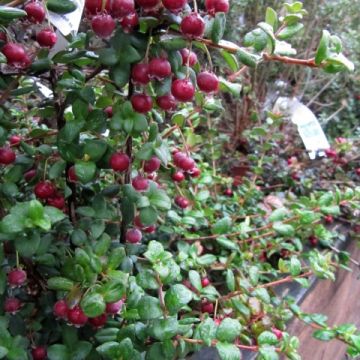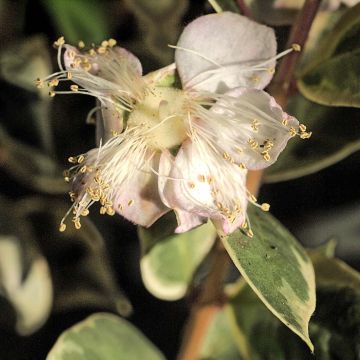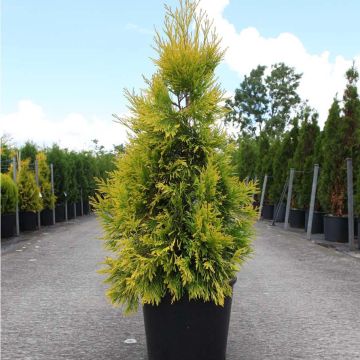

Eugenia myrtifolia New Port - Myrte d'Australie
Eugenia myrtifolia New Port
Eugenia myrtifolia New Port
Australian Brush Cherry, Scrub Cherry, Creek Lily Pilly, Creek Satinash, Watergum, Wilson's Satinash
Why not try an alternative variety in stock?
View all →This plant carries a 24 months recovery warranty
More information
We guarantee the quality of our plants for a full growing cycle, and will replace at our expense any plant that fails to recover under normal climatic and planting conditions.
From €5.90 for pickup delivery and €6.90 for home delivery
Express home delivery from €8.90.
Does this plant fit my garden?
Set up your Plantfit profile →
Description
The Eugenia myrtifolia (also known as Syzygium paniculatum) New Port is derived from a persistent tropical bush sometimes referred to as the Antilles Cherry due to its small edible fruits resembling pink cherries. With a narrow, dense and bushy habit that is easily maintained through pruning, it is ornamental all year round, offering successively red to copper-orange young shoots that contrast with the mature foliage of dark green, white flowers powdered with stamens forming a beautiful haze on the plant, and then tangy fruits, which can be enjoyed raw, in jam or jelly. Its cultivation in open ground is reserved for milder areas, as it only tolerates light frosts. Elsewhere, this Syzygium makes a beautiful conservatory plant.
The Syzygium paniculatum, from the Myrtaceae family, is widespread in the tropical forests that populate the coastal regions of Australia, specifically the northeast coast of New South Wales. In nature, it forms a true tree that can reach a height of 15 m (49 ft 2 in), but its dimensions are much smaller in cultivation, even in its native Australia. This species, paniculatum, is often confused with the Syzygium australe. Both are relatives of the clove tree, the Syzygium aromaticum, famous for its dried flower buds with a unique fragrance.
The 'Newport' cultivar is a compact form and slightly more cold-resistant, withstanding temperatures down to -5 °C at the peak for a mature plant. It is a beautiful bush that reaches an average height of 3.50 m (11 ft 6 in) with a spread of 1.75 m (5 ft 8 in) in open ground. It has rapid growth and a bushy, dense and leafy habit. The evergreen leaves are glossy, oval, leathery, measuring about 4 cm (1.6 in) long and 2 cm (0.8 in) wide. They emerge with a copper-orange-red colour and then turn shiny dark green, giving the vegetation a very decorative appearance in spring, as well as after each pruning, when new leaves are produced. The self-fertile and honey-bearing bush blooms in spring and early summer. The small white flowers, 1 cm (0.4 in) wide, have prominent stamens. Gathered in clusters, they appear in the axils of the leaves and are followed in autumn by the formation of round to oval, fleshy, shiny fruits hanging from a peduncle, which turn bright pink when ripe. They are edible and consumed in Australia as jam or eaten fresh. They have a melting texture and a refreshing, slightly sour and sweet flavour reminiscent of apple.
The Syzygium New Port is a beautiful conservatory plant in most areas. In a greenhouse or conservatory, it will form a decorative quartet with an orange tree, a Yuzu and a mimosa, evoking the gardens of the antipodes. In very mild climates, it can be used as a hedge - it tolerates pruning well - or in a border, or even in a well-sheltered orchard, among Feijoa, Mandarin trees, Myrtus ugni, Natal Plum (Carissa macrocarpa). It can also be paired with other coastal evergreen shrubs such as Olearia, Grevillea, or even red-flowered callistemons (Callistemon citrinus 'Splendens').
Report an error about the product description
Eugenia myrtifolia New Port in pictures
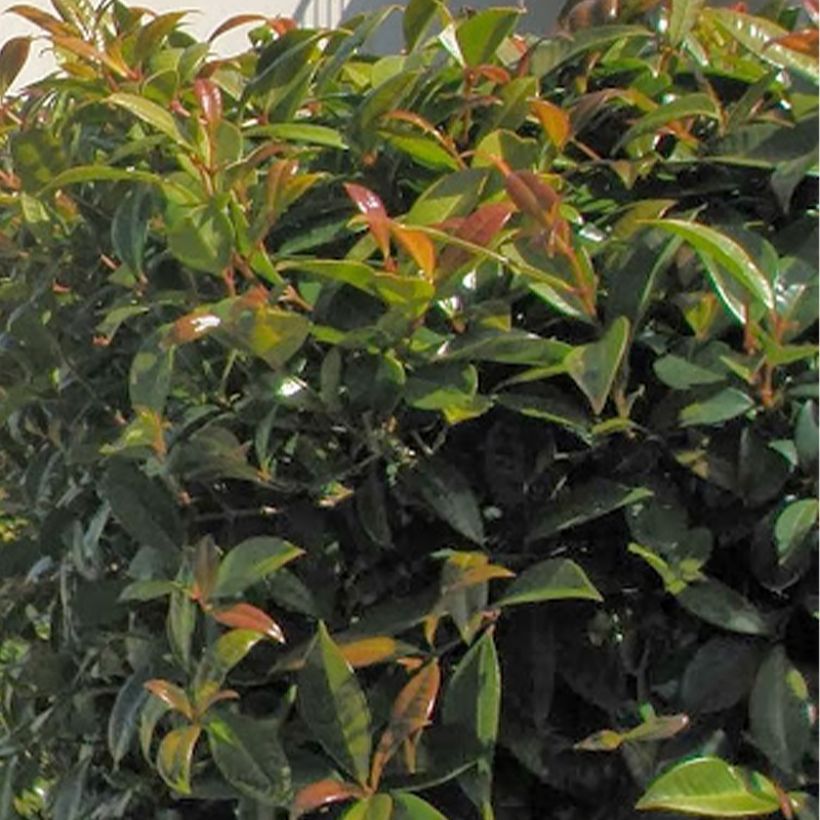

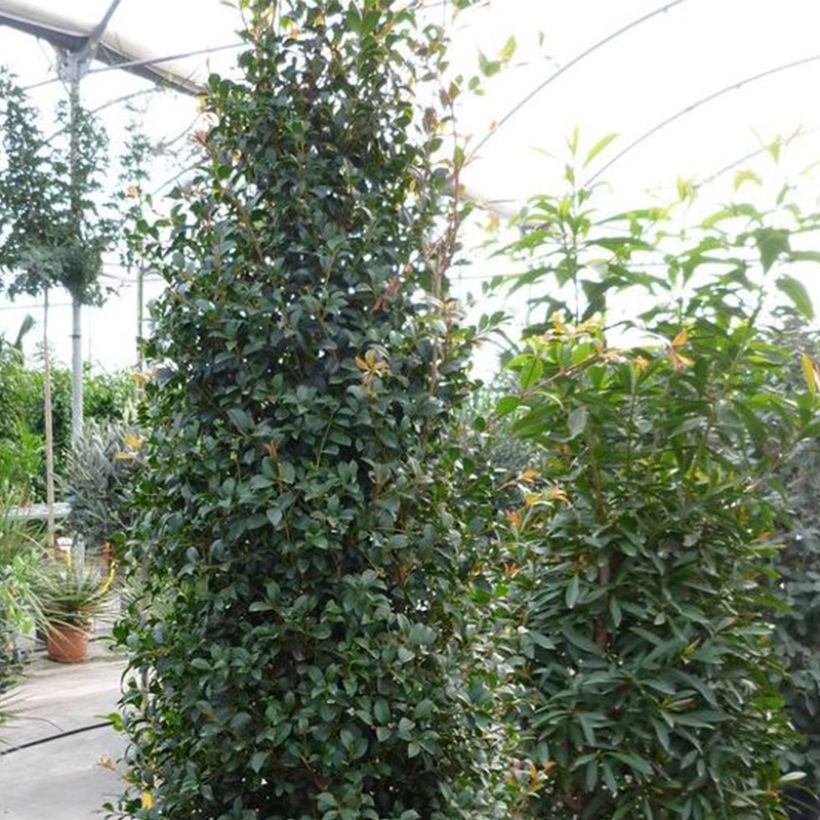

Plant habit
Flowering
Foliage
Botanical data
Eugenia
myrtifolia
New Port
Myrtaceae
Australian Brush Cherry, Scrub Cherry, Creek Lily Pilly, Creek Satinash, Watergum, Wilson's Satinash
Cultivar or hybrid
Other Myrtus - Myrtle
Planting and care
Syzygium New Port will thrive in a soft, slightly acidic, neutral or even slightly chalky soil that is well-drained but remains moist, especially in summer. It can tolerate sea spray. Plant it in the ground in spring in a very mild climate. It will flourish in full sun or partial shade, sheltered from cold winds. In these conditions, it is hardy down to -5°C (23 °F) for a short period of time. Protect it with horticultural fleece in colder regions and insulate it from the cold as much as possible. Place it in the warmest corner of the garden, in full sun against a south-facing wall. However, in cooler climates, it is best to grow it in a large pot and store it indoors during winter, in a bright but unheated room. To shape it, you can prune the stems in March-April or after flowering to encourage branching. This bush tolerates pruning well.
Cultivation in pots:
Ensure good drainage at the bottom of the pot, which should be large in size. Use lightweight soil, enriched with leaf compost, and apply some slow-release fertiliser in late winter and autumn. Water generously in summer, allowing the soil to dry out slightly between waterings. The more you water, the more your bush will flower and bear fruit. This self-fertile variety does not require the presence of another plant nearby for fruiting.
Planting period
Intended location
Care
This item has not been reviewed yet - be the first to leave a review about it.
Evergreen shrubs
Haven't found what you were looking for?
Hardiness is the lowest winter temperature a plant can endure without suffering serious damage or even dying. However, hardiness is affected by location (a sheltered area, such as a patio), protection (winter cover) and soil type (hardiness is improved by well-drained soil).

Photo Sharing Terms & Conditions
In order to encourage gardeners to interact and share their experiences, Promesse de fleurs offers various media enabling content to be uploaded onto its Site - in particular via the ‘Photo sharing’ module.
The User agrees to refrain from:
- Posting any content that is illegal, prejudicial, insulting, racist, inciteful to hatred, revisionist, contrary to public decency, that infringes on privacy or on the privacy rights of third parties, in particular the publicity rights of persons and goods, intellectual property rights, or the right to privacy.
- Submitting content on behalf of a third party;
- Impersonate the identity of a third party and/or publish any personal information about a third party;
In general, the User undertakes to refrain from any unethical behaviour.
All Content (in particular text, comments, files, images, photos, videos, creative works, etc.), which may be subject to property or intellectual property rights, image or other private rights, shall remain the property of the User, subject to the limited rights granted by the terms of the licence granted by Promesse de fleurs as stated below. Users are at liberty to publish or not to publish such Content on the Site, notably via the ‘Photo Sharing’ facility, and accept that this Content shall be made public and freely accessible, notably on the Internet.
Users further acknowledge, undertake to have ,and guarantee that they hold all necessary rights and permissions to publish such material on the Site, in particular with regard to the legislation in force pertaining to any privacy, property, intellectual property, image, or contractual rights, or rights of any other nature. By publishing such Content on the Site, Users acknowledge accepting full liability as publishers of the Content within the meaning of the law, and grant Promesse de fleurs, free of charge, an inclusive, worldwide licence for the said Content for the entire duration of its publication, including all reproduction, representation, up/downloading, displaying, performing, transmission, and storage rights.
Users also grant permission for their name to be linked to the Content and accept that this link may not always be made available.
By engaging in posting material, Users consent to their Content becoming automatically accessible on the Internet, in particular on other sites and/or blogs and/or web pages of the Promesse de fleurs site, including in particular social pages and the Promesse de fleurs catalogue.
Users may secure the removal of entrusted content free of charge by issuing a simple request via our contact form.
The flowering period indicated on our website applies to countries and regions located in USDA zone 8 (France, the United Kingdom, Ireland, the Netherlands, etc.)
It will vary according to where you live:
- In zones 9 to 10 (Italy, Spain, Greece, etc.), flowering will occur about 2 to 4 weeks earlier.
- In zones 6 to 7 (Germany, Poland, Slovenia, and lower mountainous regions), flowering will be delayed by 2 to 3 weeks.
- In zone 5 (Central Europe, Scandinavia), blooming will be delayed by 3 to 5 weeks.
In temperate climates, pruning of spring-flowering shrubs (forsythia, spireas, etc.) should be done just after flowering.
Pruning of summer-flowering shrubs (Indian Lilac, Perovskia, etc.) can be done in winter or spring.
In cold regions as well as with frost-sensitive plants, avoid pruning too early when severe frosts may still occur.
The planting period indicated on our website applies to countries and regions located in USDA zone 8 (France, United Kingdom, Ireland, Netherlands).
It will vary according to where you live:
- In Mediterranean zones (Marseille, Madrid, Milan, etc.), autumn and winter are the best planting periods.
- In continental zones (Strasbourg, Munich, Vienna, etc.), delay planting by 2 to 3 weeks in spring and bring it forward by 2 to 4 weeks in autumn.
- In mountainous regions (the Alps, Pyrenees, Carpathians, etc.), it is best to plant in late spring (May-June) or late summer (August-September).
The harvesting period indicated on our website applies to countries and regions in USDA zone 8 (France, England, Ireland, the Netherlands).
In colder areas (Scandinavia, Poland, Austria...) fruit and vegetable harvests are likely to be delayed by 3-4 weeks.
In warmer areas (Italy, Spain, Greece, etc.), harvesting will probably take place earlier, depending on weather conditions.
The sowing periods indicated on our website apply to countries and regions within USDA Zone 8 (France, UK, Ireland, Netherlands).
In colder areas (Scandinavia, Poland, Austria...), delay any outdoor sowing by 3-4 weeks, or sow under glass.
In warmer climes (Italy, Spain, Greece, etc.), bring outdoor sowing forward by a few weeks.




































